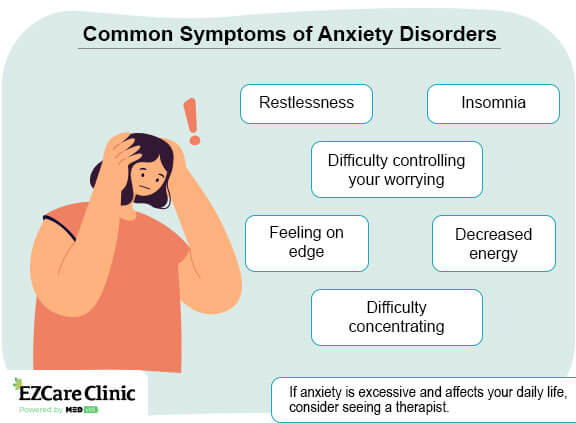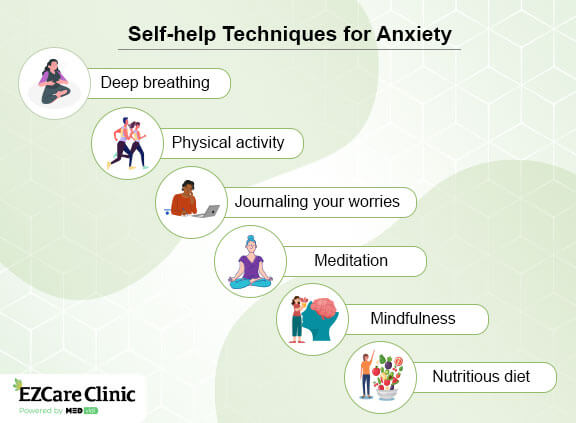For many people, anxiety can be a difficult and overwhelming emotion. If you have been feeling anxious for no reason or if you are wondering how to know if you have anxiety, taking an anxiety test may be the first step to finding it out.
Anxiety can manifest in many ways, from feeling overwhelmed to difficulty sleeping, and can be caused by a wide variety of factors. Taking an anxiety quiz can help you identify the probability of having some type of anxiety; however, only a doctor can make a diagnosis.
In our article, we share useful information on how to get tested for anxiety by taking legit anxiety disorder tests. Below, you will also find useful steps for overcoming various mental health conditions, including height phobia or social anxiety, and find out test anxiety strategies.
Take an anticipatory anxiety test and consult a doctor to overcome anxiety symptoms.
How to Know If You Have Anxiety?
Self-assessment tests for anxiety evaluation are an important way for individuals to gauge their own mental health and well-being. These tests and screenings help to alert individuals to potential issues in their lives. They can also help to open up a dialogue of support and guidance between the individual and a qualified mental health professional.
There is a wide range of self-assessment anxiety tests and screenings available online, that can help individuals to identify whether they may be suffering from the symptoms associated with an anxiety disorder. The tests and screenings work by asking a variety of questions about past and present emotional states, which can provide the individual with a clear indication of the severity of their anxiety and whether they may need to seek help from a mental health expert.
The most popular anxiety self-assessment tests and screenings are:
1.
2. The Beck Anxiety Inventory (BAI). It is a self-report instrument for measuring the severity of anxiety. This 21-item test provides a scored index of anxiety levels based on the magnitude of symptom manifestation. The BAI assesses both the physical and mental components of anxiety, helping to shape effective diagnosis and treatment. The inventory has been proven to be a reliable self-assessment tool to evaluate the presence and intensity of anxious feelings over short and long time periods.

3. The Hamilton Anxiety Scale (HAM-A). This anxiety test for adults is designed to measure the severity of anxiety. It uses a five-point Likert-type scale to rate the intensity of each symptom item, such as subjective, psychological, and somatic symptoms. The HAM-A is valid and is widely used in clinical settings for diagnosing and treating anxiety.
4.
5. The State-Trait Anxiety Inventory (STAI). It is a self-assessment tool used to measure anxiety levels in individuals. It is composed of two separate sets of 20 items, each related to either state or trait anxiety. The state items assess how an individual is feeling in the present moment, while the trait items measure the individual’s general feelings of anxiety. The STAI is a trustworthy measure of anxiety, and it has been used in multiple research studies and clinical settings to assess an individual’s anxiety and to track changes over time.
6. The Social Phobia Scale. It is an anxiety symptoms test that helps individuals identify and address their social phobia and other anxiety-related issues. The assessment consists of a series of questions related to social situations and interactions, as well as individual thoughts, feelings, and behaviors. Through this assessment, individuals gain insight into their own level of discomfort and fear in social situations and can take measures to reduce the fear and anxiety associated with social interaction. This can help individuals build confidence, manage anxiety, and promote healthy social interaction.
7. The Anxiety Sensitivity Index (ASI). It is a self-assessment tool designed to measure the degree of fear and discomfort associated with the physical symptoms of anxiety. It consists of 16 questions that measure the individual’s anticipation and expectation of negative consequences associated with physiological arousal, such as shaking, dizziness, and heart palpitations. The ASI is a good resource for individuals to assess their anxiety levels and identify areas where treatment is needed.
8. The Penn State Worry Questionnaire (PSWQ). It is a widely used tool for distinguishing symptoms of generalized anxiety disorder from other anxiety disorders. This self-report instrument consists of 16 items related to excessive worry and is often used in both clinical and research settings to measure the severity of an individual’s anxiety symptoms. With the PSWQ, individuals can self-assess and track their anxiety symptoms over time, allowing clinicians to track changes in symptoms and create individualized treatment plans.
Get your mental health evaluated by a professional and develop a personalized treatment plan.
How to Deal with Anxiety Symptoms?
General Techniques
- Recognize your triggers and try to avoid them.
- Focus on the present and the task at hand.
- Practice relaxation techniques, such as deep breathing or mindfulness.
- Break down the deed into smaller, manageable parts.
- Give yourself enough time to prepare for the deed.
- Gradually push yourself out of your comfort.
- Eat a balanced diet and exercise regularly.
- Get a good night’s sleep.
Tips for Specific Anxiety Disorders
- Tips for dealing with social anxiety include breathing exercises, questioning and challenging your negative thoughts, and paying more attention to yourself rather than the situation. People with social anxiety can also use techniques like grounding or focusing on their senses to get distracted from distressing situations.
- People with height phobia, also known as acrophobia, have an intense fear of heights. To reduce the symptoms of panic, such as increased heart rate, sweating, and difficulty breathing, many patients choose cognitive behavioral therapy and exposure therapy. The latter allows them to get exposed to the trigger in a safe space and finally eliminate the fear.
- Those feeling anxious during exams also can incorporate some test anxiety tips. These include mastering the techniques of effective studying, learning stress management techniques, and allocating specific time and place for learning. Creating routines you can follow before every test to calm down can also be beneficial.

If you don’t find these tips to be helpful for you or you would like to gain a deeper understanding and management of your anxiety triggers and causes, we recommend turning to a mental health professional. Working with a qualified MD can help you to identify and challenge negative thinking, develop coping skills, and gain insight into your anxiety so that you can take effective steps to manage it.
Conclusion
Anxiety can be a difficult emotion to deal with, but with the right guidance and support, you can learn to manage it. Taking a generalized anxiety disorder test can be a great first step in understanding your anxiety, and finding ways to cope with it.
Sign in now and schedule an appointment with a certified mental health professional to take your symptoms under control. After evaluating your mental condition, they will create the most effective treatment plan, including psychotherapy and medication if necessary.
Sources
- GAD-7 Anxiety
Source link - Latent dimensions of Social Anxiety Disorder: A re-evaluation of the Social Phobia Inventory (SPIN). (2016)
Source link







